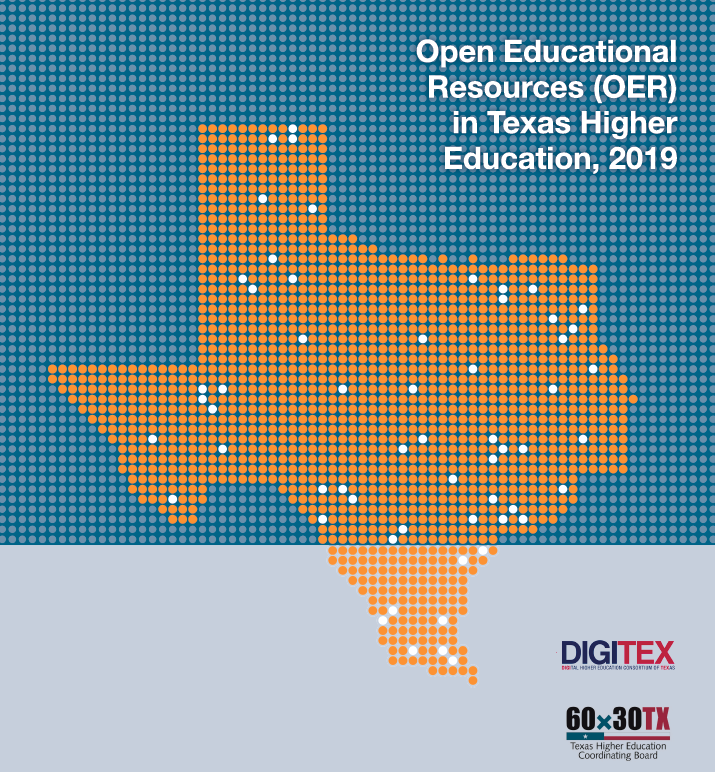The Landscape of OER Policy and Practice in Texas
Published by: WCET | 12/19/2019
Tags: Consortia, Digital Learning, Distance Education, Innovation, Managing Digital Learning, Online Learning, Open Educational Resources, Research, Survey, Technology
Published by: WCET | 12/19/2019
Tags: Consortia, Digital Learning, Distance Education, Innovation, Managing Digital Learning, Online Learning, Open Educational Resources, Research, Survey, Technology
Welcome to Judith Sebesta, Executive Director of the Digital Higher Education Consortium of Texas (DigiTex), who joins us with an update on the strategic planning process for the former Virtual College of Texas and to tell us about this year’s survey by DigiTex on Open Educational Resources (OER). Judith provides an overview of the survey results and implications about supports institutions can implement in order to support the development and use of OER on their campus.
Thank you, Judith, for today’s post!
Enjoy the read and enjoy your day,
Lindsey Downs, WCET

In spring 2019, the organization that I lead, the Digital Higher Education Consortium of Texas (DigiTex), commissioned a survey on Open Educational Resource (OER) programs, policies, and practices at colleges and universities in Texas.
Developed by the Institute for the Study of Knowledge Management in Education (ISKME), in collaboration with DigiTex and the Texas Higher Education Coordinating Board (THECB), the survey was sent to all 158 two- and four-year public and private, non-profit institutions across the state. Responses from 100 institutions painted a picture of a growing commitment to OER, not unlike other states across the country. They also revealed insights into specific priorities, practices, and perceptions surrounding OER across the Texas higher education landscape.
Before delving into those findings in a bit more detail, some context: as some of you may have read in previous posts here on Frontiers (April 19, 2019; July 17, 2019), DigiTex (formerly the Virtual College of Texas) recently underwent an extensive strategic planning process, led by Dr. Van Davis. The goal was to evaluate the efficacy and efficiency of our historical services, such as the facilitation of inter-institutional course sharing among our member community colleges. Like many institutions that participated in the 2018 WCET/Wiley Education Services report Together We Can Accomplish More: A Survey of Multi-Institution Consortia and System Leaders, it was time to repurpose ourselves to “meet changing needs” (p. 5). This included expanding our services.
One service that kept rising to the surface during the planning process was support for OER development and implementation. However, in order to strategically plan for such support, I realized that we had to better assess the needs in this area for our member colleges. Therefore, I decided to conduct an OER landscape analysis. In consultation with the THECB, it became clear that even more comprehensive statewide analyses could be beneficial for them as well – hence the collaborative project between us. I engaged ISKME because their extensive work with OER Commons and with researcher-practitioner partnerships around OER meant that they were able to drive the research with context and practical implications in mind.
Together, we identified four key research questions:
These guided the development of thirty-five questions, some original and others adapted from existing OER surveys. In May 2019, the THECB sent the survey to chief academic and instructional officers at the member campuses. We asked these administrators to either complete the survey or to forward the survey to the most appropriate individual for answering questions about OER.
Of the 100 respondents:
In October we published the final report on the survey. Here I will highlight some of the key findings as well as implications from the analysis of the survey results.
This is merely a snapshot of the findings, and more details can be found in the final report (as well as a copy of the survey instrument).
Clearly, as in many other states, there is a growing commitment to OER across Texas, as indicated by the percentage of institutions with programs or policies in place:

The survey also revealed that affordability and access are key drivers of OER, although teaching and learning benefits play a role in goals for OER use:

However, only 39% of institutions have a written definition of OER, either their own definition or they use the definition officially adopted by the state of Texas. Explicit open licensing policies in support of OER are limited, with only 7% of institutions reporting that they have a policy in place.
In 2017, during the 85th regular session, the Texas legislature passed SB 810, which stipulates that institutions share searchable information with students about courses that use OER. The survey revealed that the majority of institutions have implemented this requirement, albeit in a variety of ways:
| Listed as OER through the campus bookstore | 41% |
| Notation/description provided under individual course listing | 29% |
| Links to all OER courses provided on the landing page | 7% |
| OER search field provided on subsequent pages (not on the landing page) | 4% |
| Other | 4% |
| Not applicable, not yet implemented | 39% |
Terms used to mark courses that use OER vary, with some institutions using instead “low cost,” “free,” “zero cost,” or “affordable.”
We also found that libraries serve as a key source of funding for OER, and their staff play an integral role in enabling OER. Other findings include that cross-institutional partnerships are growing, data collection on the impact of OER is nascent, yet promising, and lack of faculty awareness and existing priorities serve as principal barriers to OER.
Overall, looking across the nine institutions that reported having both policies and programs in
support of OER, we found that they tend to:
These could indicate models for best practices for institutions looking to enable OER on their own campuses.
Key implications from the survey center on operational supports that will enable institutions to:
My organization hopes to provide, at various levels, such operational supports to our member institutions. Because the credentials at community colleges in recent years that have had the highest enrollments and completions are in career and technical fields such as nursing and welding technology, we hope to focus on the final implications mentioned above in the near future. Accordingly, we have built such a goal into our strategic plan – and hopefully this helps to support the goals of Texas’ statewide plan for higher education. Furthermore, our plan is for the landscape analysis to be conducted every two years, with this first one serving as a baseline for future comparative analyses and tracking of statewide OER activities.
Stay tuned for an update on our progress on these initiatives!

Judith Sebesta, Ph.D.
Executive Director
Digital Higher Education Consortium of Texas
Judith.sebesta@austincc.edu
www.digitex.org
